|
CRUISING
Vs FLYING CO2
ABOUT -
CIRCUMNAVIGATION
- CONTACTS - FOUNDATION -
HOME - A-Z INDEX
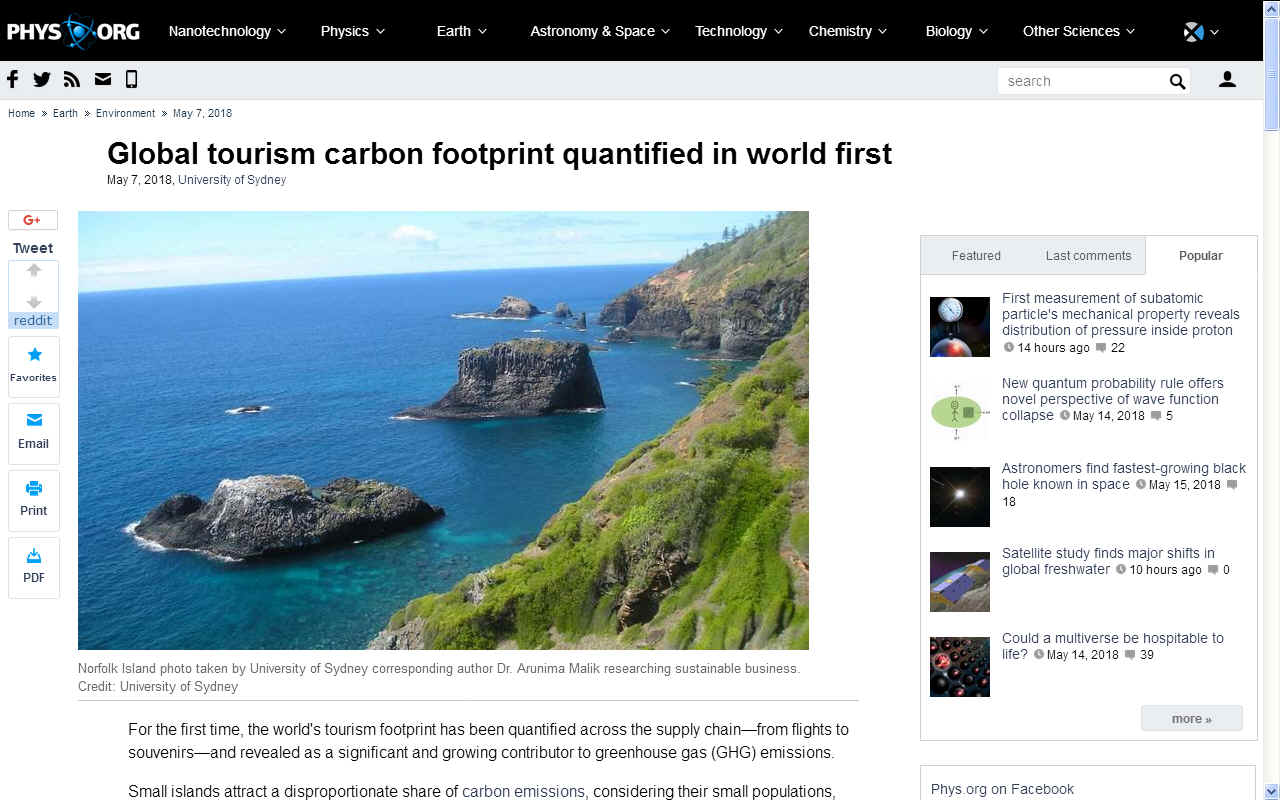
REPORT
- The first report of its kind quantifies the damage we are
doing to our planet from traveling, with air travel being the
worst offender.
Zero
carbon ships and boats are vessels that use renewable
energy to power
themselves through the water, no matter what the type of ship.
Before the advent of coal
powered steam ships, sailing (tall ships) were all green and
non polluting in terms of climate
change.
Reciprocating piston steam engines led to steam turbines with the famous
Turbinia from Charles
Algernon Parsons. Then
came diesel engines and worst of all nuclear powered submarines
and aircraft
carriers, none of which is ultimately sustainable for a
truly circular economy.
Whereas our economies are reliant on
cheap ocean transport for international trade - something that
we take for granted with globalization; ignoring the harm that
the burning of fossil fuels is causing.
That said, MARPOL,
marine anti-pollution legislation is beginning to bite with LNG
powered ships kicking off a move to cleaner burning internal
combustion engined leviathans. The fact is that cargo
ships are still the most efficient way of moving goods around
the world and we cannot do without them - so must work toward
vessels that are totally clean running, while allowing fleet
operators to reap the rewards of current investments so that
forward profits may be invested in zero carbon transport. See Maritime
2050 from Chris
Grayling.
PHYS.ORG
MAY 7 2018
For the first time, the world's tourism footprint has been quantified across the supply chain—from flights to souvenirs—and revealed as a significant and growing contributor to
greenhouse gas (GHG) emissions.
Small islands attract a disproportionate share of carbon emissions, considering their small populations, through international arrivals, while the
United States is responsible for the majority of tourism-generated emissions overall.
The research - led by world-leading Integrated Sustainability Analysis supply-chain research group at the University of Sydney
- found the global comprehensive tourism footprint of tourism-related greenhouse gas emissions is about four times greater than previous estimates, is growing faster than international trade and is already responsible for almost a tenth of global GHGs.
The researchers recommend financial and technical assistance could help share burdens such as
global warming on winter sports, sea-level rise on low-lying islands and pollution impacts on exotic and vulnerable destinations.
A key recommendation: fly less and pay more, for example for carbon abatement.
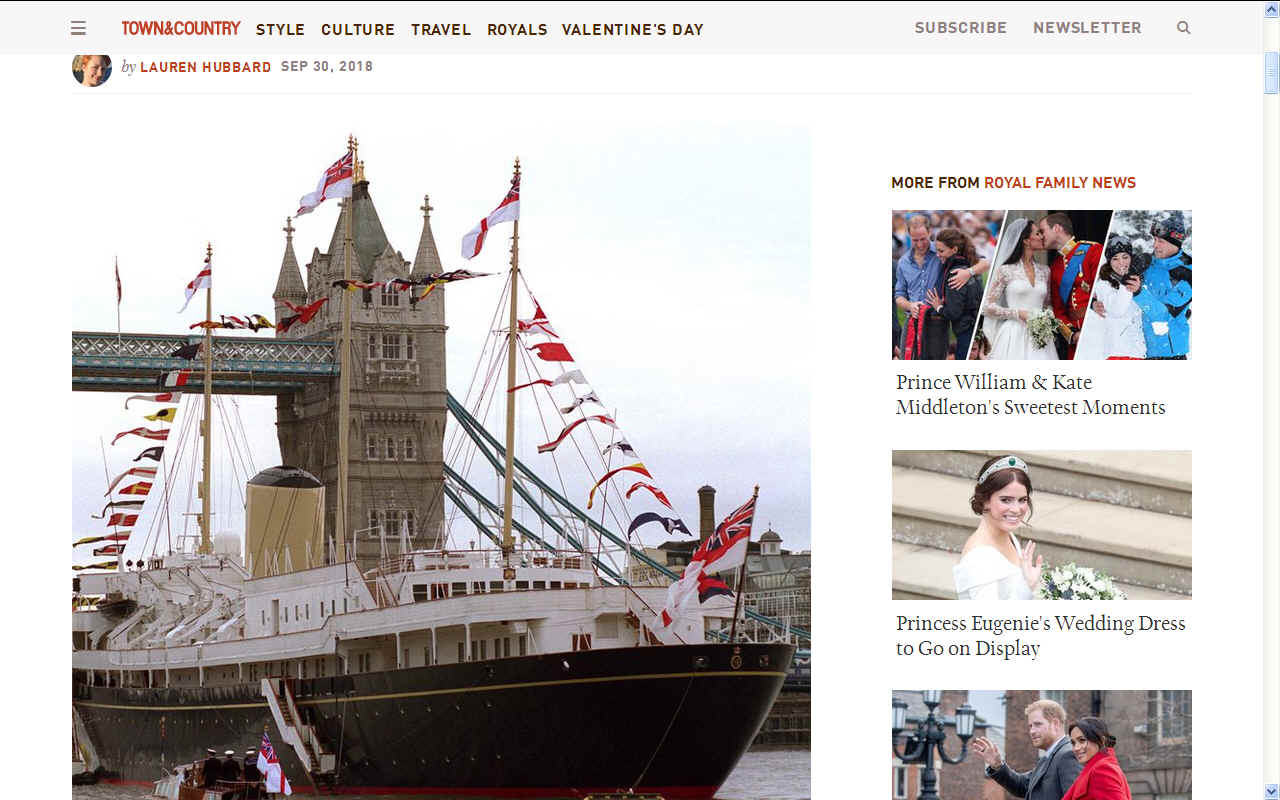
ROYAL
GAS GUZZLER
- The Royal Yacht Britannia drew a lot of attention in days
gone by when in port. But these days a ship of such lo-tech
design and proportions might be seen as a significant
contributor to global
warming, tending to offset any usefulness that the occasional
trade envoy or goodwill mission might achieve. A Royal yacht
that is zero carbon might go some way to offsetting such
reservations, especially if the technology were British and
exportable.
A paper about the findings, 'The carbon footprint of global tourism', publishes today in the peer-reviewed journal Nature Climate Change.
Corresponding author Dr. Arunima Malik, from the School of Physics, said the complex research took a year and a half to complete and incorporated more than an estimated one billion supply chains and their impacts on the atmosphere.
"Our analysis is a world-first look at the true cost of tourism
- including consumables such as food from eating out and souvenirs—it's a complete life-cycle assessment of global tourism, ensuring we don't miss any impacts," Dr. Malik said.
"This research fills a crucial gap identified by the World Tourism Organization and World Meteorological Organization to quantify, in a comprehensive manner, the world's tourism footprint."
Co-author Dr. Ya-Yen Sun, from the University of Queensland's Business School and the National Cheng Kung University, Taiwan, said a re-think about tourism as 'low-impact' was crucial.
"Given that tourism is set to grow faster than many other economic sectors, the international community may consider its inclusion in the future in climate commitments, such as the Paris Accord, by tying international flights to specific nations," she said.
"Carbon taxes or carbon trading schemes - in particular for
aviation - may be required to curtail unchecked future growth in tourism-related emissions."
Lead researcher from the University of Sydney, Professor Manfred Lenzen, said the study found air travel was the key contributor to tourism's footprint and that the carbon-intensive industry would comprise an increasingly significant proportion of global emissions as growing affluence and technological developments rendered luxury travel more affordable.
"We found the per-capita carbon footprint increases strongly with increased affluence and does not appear to satiate as incomes grow," Professor Lenzen said.
For holiday-makers, Professor Lenzen said paying for carbon abatement could increase the price of a trip significantly, pointing to previous research* indicating robust offset schemes did not amount to small change.
"To make my own travel more sustainable - for future generations
- I invest in long-run abatement options at prices that incorporate at least average abatement costs, like investing in afforestation, rather than assuming only low-hanging fruit, like residential power efficiency."
"If I flew from Melbourne to the UK return, I would pay at least an additional $425** to offset my emissions; for a return trip between Sydney and Brisbane, about $45 extra," Professor Lenzen said.
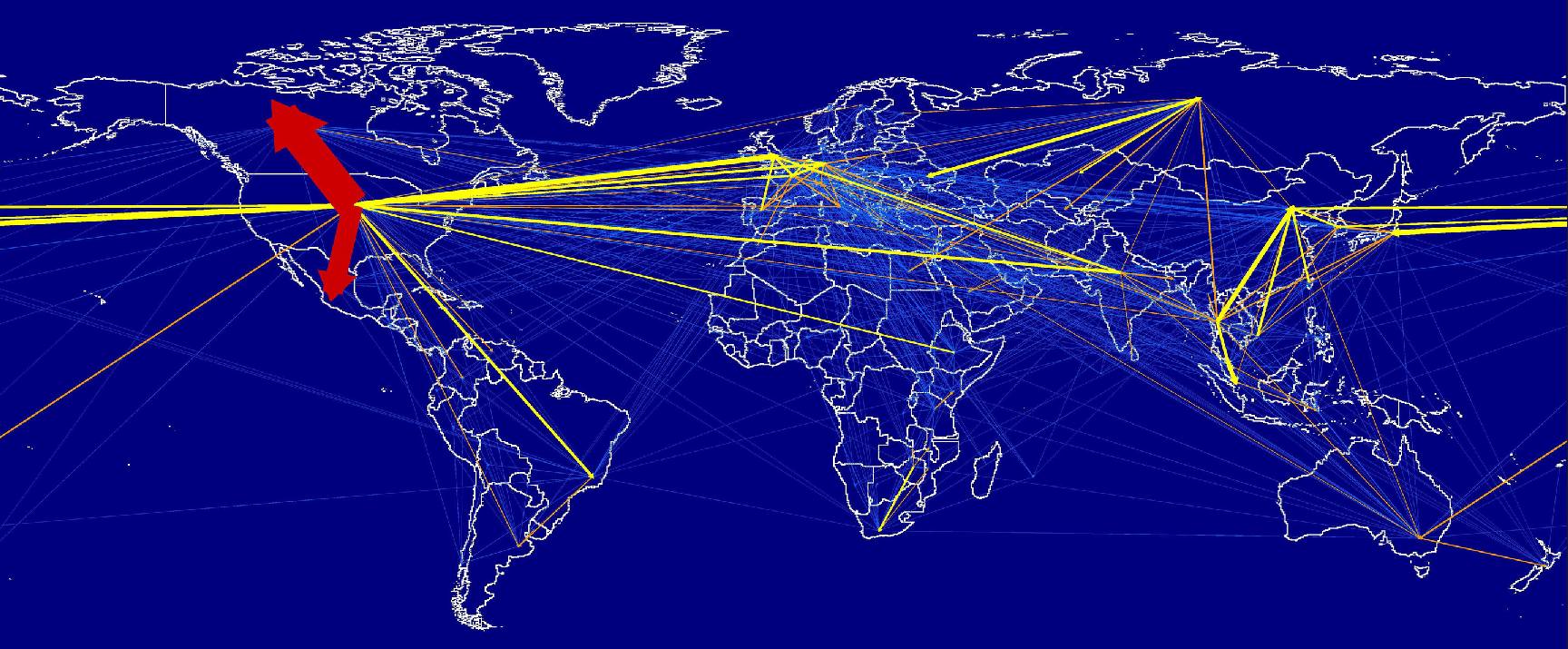
Previous research has quantified the carbon footprint of specific aspects of tourism operations such as hotel, events and transportation infrastructure; and in particular countries or regions.
This new study included 189 individual countries and all upstream supply chains.
The US tops the carbon footprint ranking, followed by China, Germany and India. The majority of these carbon footprints are caused by domestic travel; business travel could not be distinguished from tourism.
In countries such as the Maldives, Mauritius, Cyprus and the Seychelles, international tourism represents between 30 percent and 80 percent of national emissions.
The paper notes international arrivals and tourism receipts have been growing at an annual three percent to five percent—outpacing the growth of international trade.
The study found tourism is forecast to grow at an annual four percent—outpacing many other economic sectors.
Between 2009 and 2013, tourism's global carbon footprint increased from 3.9 to 4.5 Gt CO2-e—four times more than previous estimates—accounting for about 8 percent of global greenhouse gas emissions. Transport, shopping and food are significant contributors.
Explore further: Decarbonizing tourism: Would you pay US$11 for a carbon-free holiday?
More information: Manfred Lenzen et al, The carbon footprint of global tourism, Nature Climate Change (2018). DOI: 10.1038/s41558-018-0141-x
* 'The social cost of carbon: estimating the benefits of reducing greenhouse gas emissions'. US Environment Protection Agency 19 January 2017.
** For the purposes of providing an example of average abatement costs of popular trips, Prof Lenzen estimated:
short-haul/domestic flights emit 0.5 kg per passenger kilometre (reference:
www.sciencedirect.com/science/ … ii/S1361920999000097) on a life-cycle basis, times typical abatement cost of AU $50/tonne (reference:
openknowledge.worldbank.org/bi … 11296.pdf?sequence=4) yields 2.5 cents/km flown, or $45 for a 2x900 km return trip.
long-haul/international flights emit 0.25 kg/pkm on a life-cycle basis (reference: www.sciencedirect.com/science/ … ii/S1361920999000097), times typical abatement cost of AU $50/tonne (see 1st two References above) yields 1.25 cents/km flown, or $425 for a 2x17,000 km return trip.
(However, if assuming high, rather than average abatement costs, assuming all other abatement options have been exhausted for the longer-term, the cost of abatement could be increased two- or threefold.)
Journal reference: Nature Climate Change
Provided by: University of Sydney
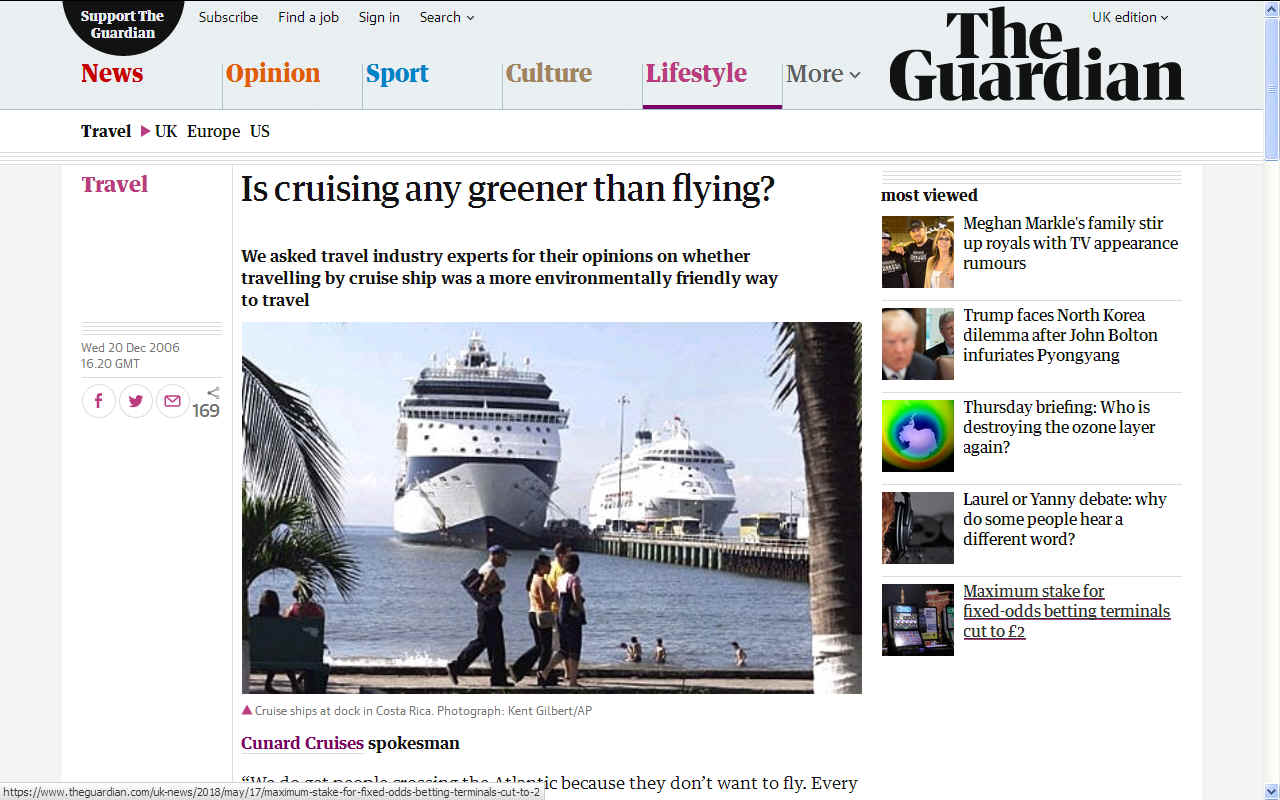
THE
GUARDIAN 20 DECEMBER 2006 - IS CRUISING ANY GREENER THAN FLYING?
We asked travel industry experts for their opinions on whether travelling by cruise ship was a more environmentally friendly way to travel
Cunard Cruises spokesman
“We do get people crossing the Atlantic because they don’t want to fly. Every ship has to meet environmental targets and the Queen Mary II has a zero-discharge policy.”
Climate Care, carbon offsetting company
“According to our calculations, a cruiseliner such as Queen Mary 2 emits 0.43kg of CO2 per passenger mile, compared with 0.257kg for a long-haul flight (even allowing for the further damage of emissions being produced in the upper atmosphere). Sometimes our instincts about what’s best for the environment are wrong and this shows the importance of calculating the actual carbon emissions from different activities and making our decisions - both as individuals and government policy - based on the real numbers. We would certainly welcome the cruise liner industry taking a closer look at their carbon footprint. As these figures show, it is not negligible.”
Richard Hammond, the Guardian's green travel columnist
"Quite aside from the carbon emissions, there is a high cost to the ocean. The cruise industry has a poor record in terms of waste water treatment and disposal, and therefore it has to clean up its act if it is to be considered as an environmentally friendly means of travel. The size of the industry is also crucial: cruising is the fastest growing sector of the travel industry. In 2003, 9.3 million passengers took a cruise while the International Eco-tourism Society projects that 17 million passengers will do so in 2010.”
Gwyn Topham, author of Overboard: the stories cruise lines don't want told
“Mile for mile, the carbon footprint for a cruise is worse - and many passengers will take planes to join a cruise. Since the big cruise lines were hit with massive fines in the US for polluting waters a few years ago, they have made improvements - but ships are not facing that same kind of scrutiny outside Alaska and California. The overall benefits to the ports of call are questionable. And while environmentalists do generally agree that new ships are greener, it takes a long time to adapt older ships and in many areas - such as cleaner fuel, better waste treatment systems - campaigners think cruise lines aren't doing nearly enough.”
Tricia Barnett, director of Tourism Concern
"It’s not greener, and it's a much broader issue than carbon emissions alone. Cruise ships are the ultimate all-inclusive holiday experience where everything is paid for before you board. So the benefits to locals when you dock are minimal, but they have to deal with the waste that the cruise ship leaves behind. While you're on board huge amounts of electricity will be used to provide everyone with the services they expect.”
Justin Francis, Responsible Travel
“You might naturally assume that a ship would emit less carbon dioxide than a long-haul flight but it’s not the case. On a typical one-week voyage a cruise ship generates more than 50 tonnes of garbage and a million tonnes of grey (waste) water, 210,000 gallons of sewage and 35,000 gallons of oil-contaminated water. Some of this is pumped into ocean and some treated.
The cultural impact of large numbers of tourists descending on, in some cases, small destinations has also been overlooked. People are after simple answers, simple solutions. But we’ve oversimplified it with flying: if people really want to reduce their carbon, they can make a larger difference by lagging their boiler or taking showers not baths, rather than cutting out a flight to somewhere which needs it.”
George Monbiot, environmental campaigner and author
“There are remarkably few figures. But George Marshall of the Climate Outreach Information Network has conducted a rough initial calculation for the Queen Elizabeth II. Cunard says the ship burns 433 tonnes of fuel a day, and takes six days to travel from Southampton to New York. If the ship is full, every passenger with a return ticket consumes 2.9 tonnes. A tonne of shipping fuel contains 0.85 tonnes of carbon, which produces 3.1 tonnes of carbon dioxide when it is burnt. Every passenger is responsible for 9.1 tonnes of emissions. Travelling to New York and back on the QEII, in other words, uses almost 7.6 times as much carbon as making the same journey by plane.”
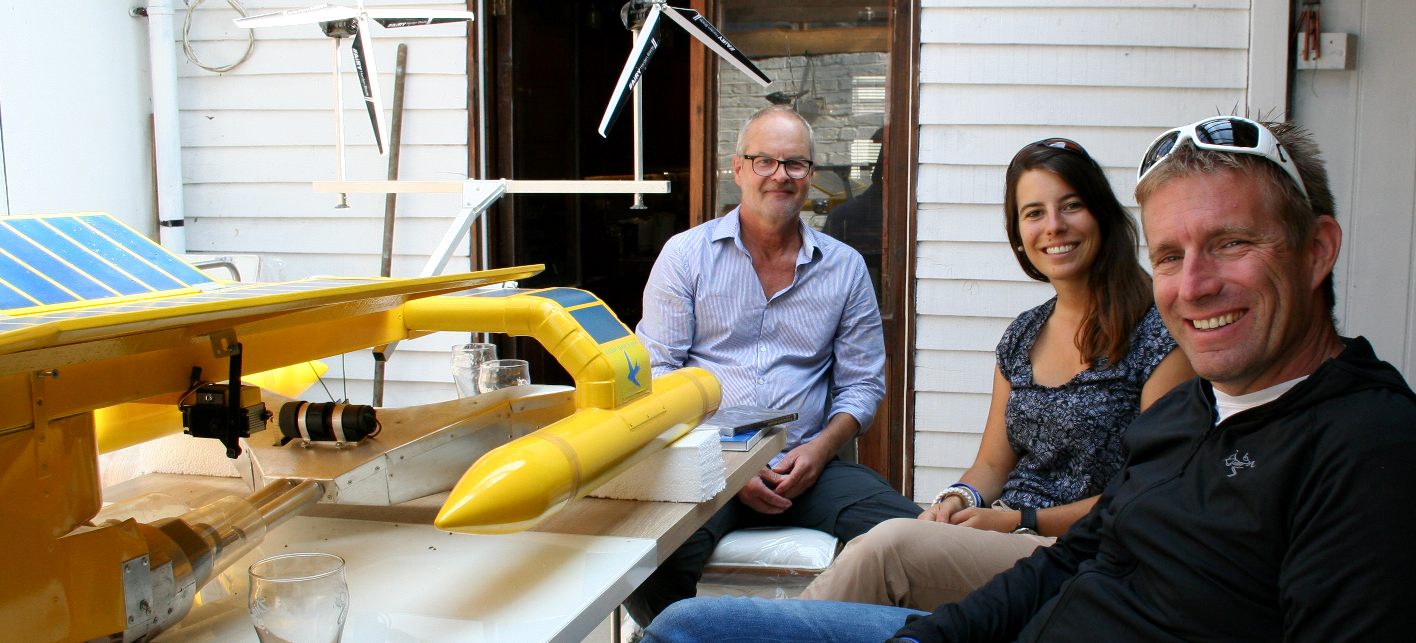
SOLAR
PIONEERS
- Stephane Chopard & Raphaelle Javet (communications) and Raphael
Domjan (pilot) on a visit to the SeaVax solar powered
project in Britain in August 2017. Raphael set the zero carbon
cruising benchmark with PlanetSolar
in 2012.
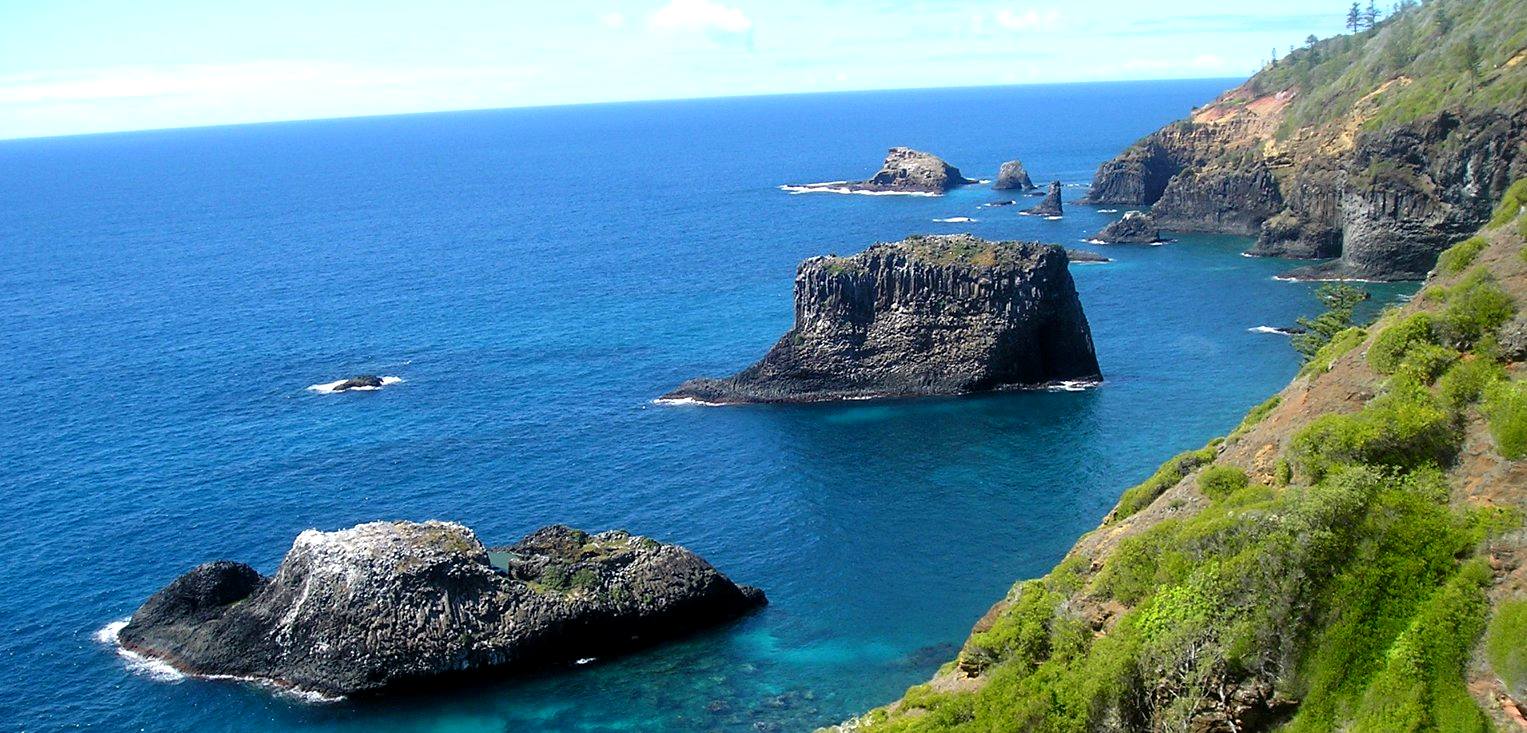
LLOYD'S
AWARDS 2015 - Initiated
RETURN
TO NATURE
One
of the first true (blue-water) green ships, was the Planet
Solar that in 2012 set a world first record for a solar
powered circumnavigation.
Other landmark vessels include the Solarsailer, and now there
is a move to wind and
solar assisted cargo ships, some of
which are fitted with solar panels.
Eventually,
it is hoped that internal combustion power can be replaced
altogether with wind and solar powered ships like the SeaVax
and Bluefish
concepts that are under development (subject to funding). This
will only happen with the support of the people and the
political will to change.

SOLAR
POWERED VESSEL - This vessel is designed to operate in fleets
to target ocean waste before it settles on the ocean floor
where nobody can recover it. There is nothing like it in
existence today, though other ideas for trapping plastic waste
are being developed, such as that of Boyan
Slat and the Seabin.
SIX
STEPS TOWARD A COOLER PLANET
1.
TRANSPORT:
Phase out polluting
vehicles. Governments aim to end the sale of new petrol, and
diesel vehicles by
2040 but have no infrastructure plan to support such
ambition. Marine transport can be carbon neutral.
2.
RENEWABLES:
Renewable energy should replace carbon-based fuels
(coal, oil and
gas) in our
electricity, heating and transport.
3.
HOUSING: On site micro or macro
generation is the best option, starting with new build homes.
4.
AGRICULTURE: We need
trees to absorb
carbon emissions from a growing population, flying, and to build
affodable new homes. Reducing food waste and promoting
less energy intensive eating habits such as no meat Mondays.
5.
INDUSTRY: Factories should be aiming for solar heating and
onsite renewable energy generation.
6.
POLITICS: - National governing bodies need to adopt
rules to eliminate administrative wastages, to include scaling
down spending on war machines, increasing spend on educating the public and supporting sustainable
social policies that mesh with other cultures. One way of
pushing this agenda is total transparency
in Governments and Courts as per United
Nations SDG 16. This would tend to prevent corrupt
politicians and civil servants from pursuing unlawful agendas.
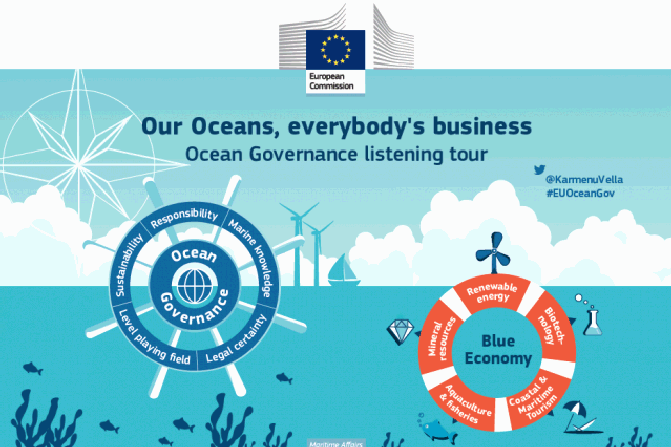
MAIN
BLUE GROWTH AREAS
5.
Ocean Regeneration - cleaning our oceans to preserve the
resource and cleanse the toxic food chain
6.
Aquaculture - now generates around 50% of world produce,
mostly subject
to wild fish feed
7.
Ocean Energy - offshore wind and wave energy for clean
power
8.
Biotechnology - Identifying, harvesting and producing
medicines
9.
Coastal Tourism - To engage the public in ocean matters
and reduce air travel
10.
Green Ships - Cargo and cruise ships that are cleaner,
preferably zero carbon
LINKS
& REFERENCE
https://www.theguardian.com/travel/2006/dec/20/cruises.green
https://phys.org/news/2018-05-global-tourism-carbon-footprint-quantified.html

MARINE
LIFE - This humpback whale is one example of a magnificent
animal that is at the mercy of human
activity. Humans are for the most part unaware of the harm their fast-lane
lifestyles are causing. We aim to change that by doing all we
can to promote ocean
literacy.
This
website is provided on a free basis as a public information
service. Copyright © Cleaner
Oceans Foundation Ltd (COFL) (Company No: 4674774)
2019. Solar
Studios, BN271RF, United Kingdom.
COFL
is a charity without share capital.
|







